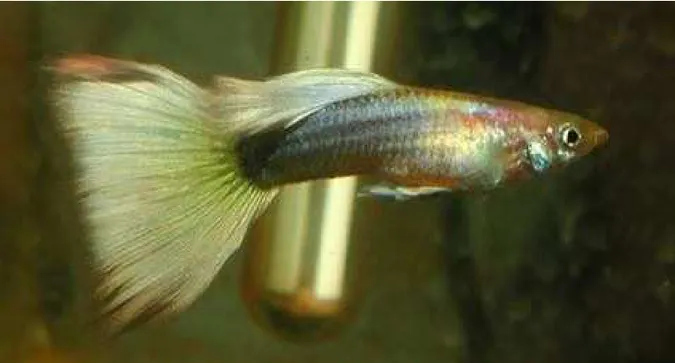161
AACL BIOFLUX
Aquaculture, Aquarium, Conservation & Legislation
International Journal of the Bioflux Society
Blond: a regulatory gene in the guppy (
Poecilia
reticulata
Peters 1859)
1
Philip Shaddock
Abstract. The present letter is a response to the paper „Interallelic interaction between the autosomal Blond and the sex-linked Nigrocaudatus gene in the guppy (Poecilia reticulata)” (Petrescu-Mag et al 2007).
Key Words: Guppy, Poecilia reticulata, Gold, Blond, Nigrocaudatus.
Resumen. Esta carta es una respuesta al trabajo „Interallelic interaction between the autosomal Blond and the sex-linked Nigrocaudatus gene in the guppy (Poecilia reticulata)” (Petrescu-Mag et al 2007).
Plabras clave: Guppy, Poecilia reticulata, Gold, Blond, Nigrocaudatus.
Rezumat. Această scurtă comunicare este un raspuns la lucrarea „Interallelic interaction between the autosomal Blond and the sex-linked Nigrocaudatus gene in the guppy (Poecilia reticulata)” (Petrescu-Mag et al 2007).
Cuvinte cheie: Guppy, Poecilia reticulata, Gold, Blond, Nigrocaudatus.
Letter. Petrescu-Mag et al (2007) conducted some guppy crosses (see Figure 1) and concluded that the “... autosomal Blond gene is recessive to its wild allele and is expressed in homozygote form only. In this form, it partially suppresses both the
Nigrocaudatus and other melanistic genes due to a low level of melanin synthesis ... In the presence of its wild allele (B) the blond trait is not expressed at all, but in homozygote form it is epistatic to all the melanistic genes known in the guppy, including
Nigrocaudatus gene” (Petrescu-Mag et al 2007).
According to Goodrich et al in their 1944 paper “The cellular expression and genetics of two new genes in Lebistes reticulatus” the blond mutation affects the size and distribution of melanophores. In a diagram (see Figure 2), Goodrich et al show the difference in size and density of melanophores in wild (A), golden (B), blond (C) and the double mutant cream (D).
The small and thinly distributed blond melanophores naturally contain less melanin than the larger wild type. So blond is not a mutation directly affecting melanin sythesis. It is because the melanophores are so small in size and number that blond guppies look less dark than their wildtype counterparts.
162
Figure 1. The genotypes resulted in F1 and FB progeny after Half-Black X Red Blond crossing (Petrescu-Mag et al 2007).
163
But the question remains: why is the guppy with the Nigrocaudatus gene showing black color in the half-body?
The melanophores in the half-black area of the body were studied by Nayudu & Hunter in their 1979 paper “Cytological aspects and differential response to melatonin of melanophore based color mutants in the guppy”. In that paper they foundmelanophores to be ectopic, observed in all layers of the skin, and much larger than normal. In other words, they were mutant.
Does the blond gene actually affect the expression of the Nigrocaudatus gene then? Since the blond gene does not affect melanin synthesis, but rather reduces the size of normal melanophores, you would expect normal black color to be reduced in the entire body, including the half-black peduncle. But if the blond gene does not affect the mutant melanophores found in the half-black area of the peduncle, then you would expect the expression of the Nigrocaudatus gene to be unaffected by the blond gene. That would also explain why Petrescu-Mag et al (2007) got blond guppies. An example of such a guppy with a very black peduncle is this one from our tanks (see Figure 3).
Figure 3. Half-Black guppy with the Ni Ni b b genotype (Photo by Philip Shaddock).
If the blond mutation were affecting melanin synthesis, you would not get such a black peduncle. What we think is that mutations in the guppy are color cell type specific. This is the explanation for the blond guppy showing black color in the peduncle.
This makes sense, because if the golden and blond genes are in fact regulatory genes, they would be upstream from the structural melanophore cell gene on the autosomal chromosome. The mutant melanophore in the half-black area may be due to a sex-linked structural gene and therefore unaffected by the blond regulatory genes.
References
Goodrich H. B., Josephson N. D., Trinkaus J. P., Slate J. M., 1944 The cellular expression and genetics of two new genes in Lebistes reticulatus. Genetics 29(6):584–592. Monod J., Cohen-Bazire G., Cohn M., 1951 [The biosynthesis of β-galactosidase (lactase)
in Escherichia coli. The specificity of induction]. Biochim et Biophys Acta 7:585-599. [in French]
164
Petrescu-Mag I. V., Lozinsky R. L., Hărşan R., Csép L., Boaru A. M., 2007 Interallelic interaction between the autosomal Blond and the sex-linked Nigrocaudatus gene in the guppy (Poecilia reticulata). AIR 2(1).
Received: 15 December 2008. Accepted: 25 December 2008. Published: 30 December 2008. Author:
Philip Shaddock
How to cite this article:
Shaddock P., 2008 Blond: a regulatory gene in the guppy (Poecilia reticulata Peters 1859). AACL Bioflux 1(2):161-164.
Printed version: ISSN 1844-8143

